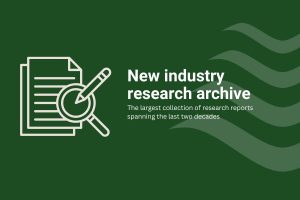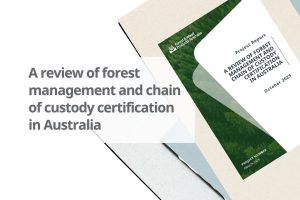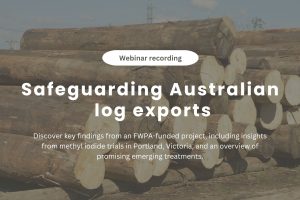Advanced technologies being used in Tasmania to monitor wedge-tailed eagle nests could be the first step towards developing a ‘fully networked’ forest. But what does this mean, exactly?
A networked or digital forest is one equipped with permanently installed technologies that continually collect and broadcast real-time data, before beaming it back to forest managers to support better decision making.
The research into the use of technologies to monitor eagle nests contributes to a broader research program being led by the Forest Practices Authority (FPA), which is responsible for regulating Tasmanian forestry. It will monitor industry impacts on four protected Tasmanian species.
Supported by FWPA under the voluntary matched funding program, the initiative will observe the movements and habitat requirements of wedge-tailed eagles, Tasmanian devils, masked owls and giant freshwater crayfish.
The results will be used to improve our understanding of the effectiveness of current protocols that guide forest management practices for the protection of these species. This knowledge will help determine whether new or adapted approaches could better protect the animals and minimise the impact on forestry operations.
“The public is concerned about high-profile species such as wedge-tailed eagles, and members of the forestry industry are as keen as everyone else to make sure their operations don’t have a negative impact,” said FPA Biodiversity Research Manager, Dr Amy Koch.
The eagle nest monitoring project, funded through the National Institute for Forest Products Innovation (NIFPI), is being led by Dr Dean Williams, Manager, Forest Management Services, Sustainable Timber Tasmania, and will utilise wireless ‘Industrial Internet of Things’ remote sensing technologies to improve eagle management options for the forestry industry by detecting and reporting on eagle nesting activity.
The project is effectively sowing the seeds for the ‘digital forest’ of the future. It’s hoped that effectively demonstrating the potential for this kind of technology to support forest management could prompt the establishment of a digital information ecosystem across the Tasmanian landscape, and beyond!
Across Tasmania, there are approximately 800 wedge-tailed eagle nest sites that can affect forest management activities. However, only 80 to 120 of these nests are used each breeding season (July to January, or February if the season runs late). Currently, all nests are protected during breeding season via operational exclusion zones, which prohibit many forest management practices from taking place in these zones. These exclusion zones remain in place until a nest is confirmed to be inactive. However, current processes for checking nest activity are expensive and risky to workers and animals.
“Annual nest activity checks during breeding season are carried out by highly experienced observers, flown over the forest in a helicopter, close enough to the nests to check for activity. The observer then prepares and submits a written report to the land manager, which informs their operational decisions,” said Williams.
“Things like static cameras have also been used to monitor nest activity, but their use is limited to only a few months due to short battery life. They are also not networked, meaning they need to be physically retrieved from the nest to download the images.”
To overcome all of this, the researchers are testing different sensors to determine the best options to reliably monitor and report on activity in wedge-tailed eagle nests under natural conditions, over multiple years, and in the most unobtrusive way possible. The project commenced in mid-2019 and will run until mid-2021, covering two breeding seasons.
In the case of wedge-tailed eagles, this speedy identification of inactive nests could allow for business operations to continue or commence where they would otherwise have been delayed due to precautionary operational exclusions.
The trial involves a sample of 16 nests, complemented by the establishment of a network of gateways (or wireless modems) installed across the landscape. These will also be tested, for effectiveness at collecting and forwarding sensor data from remote locations.
“Our project brings together specialists in the fields of sensor technology, wireless networks, forest and power infrastructure management, and wildlife management and conservation. These specialists are highly motivated to find an efficient and cost-effective alternative to current management practices, while improving conservation and commercial outcomes,” said Williams.
The data collected has the potential to be integrated into existing business operating systems such as geographic information systems (GIS), allowing forest managers to make the best decisions for their operations, while taking into consideration wedge-tailed eagle breeding activities. Beyond this, the possibilities offered by a fully ‘networked’ forest are endless.
“The sensors being tested are low powered and have a battery that can last for ten years. So once in place, they can be used for a long time. This project is therefore the nucleus for a broader concept that could be adopted state-wide, nation-wide, or even globally,” explained Williams.
“These kinds of sensor and communications technologies are already being used successfully in other commercial fields, ranging from water management, to transport and logistics. And in the urban environment they are routinely and successfully used for a variety of monitoring purposes, so why not in forest environments too?”
Dr Williams views a fully networked, digital or ‘smart’ forest as one in which multiple points are used to collect information about various conditions, ranging from wildlife to environmental, weather, vehicles, and fuel moisture levels, the latter of which could provide a vital fire management tool.
“It’s all about being better informed about what’s going on in the forest,” explained Williams.
“Whether your objectives are conservation, wood production, or a combination of both, using technology to gather quality information to make the best decisions you can represents advantages for all.
“This technology is scalable and can be ramped up quickly. With lots of sensors providing lots of data, we need to consider the AI and machine learning options that can be used to analyse and interpret the data, and present it in the most meaningful way. The ideal scenario is a user-friendly interface available to foresters, containing real-time insights that can inform decision making.”
The concept could help forest managers to appropriately meet requirements set by the FPA, and effectively support the enforcement of any new or adapted regimes. Other advantages include a reduced need for humans to physically go out into the forest to perform checks, particularly in difficult-to-access or unsafe locations.
“Looking to the future, we’d love to see a service provider take over the setting up and maintenance of networked forests,” said Williams.
The eagle nest monitoring work itself has already been acknowledged by the 2020 TasICT Excellence Awards, in the category Best Contribution to Sustainability or Protection of the Environment, and according to Williams, the industry has been equally enthusiastic.
“We have lots of industry partners involved, with a steering committee of industry stakeholders, and feedback has been incredibly positive. It’s great to know they can see the potential of this technology, beyond this initial eagle nest monitoring work, and for the support of a multitude of different forest management practices,” concluded Williams.



